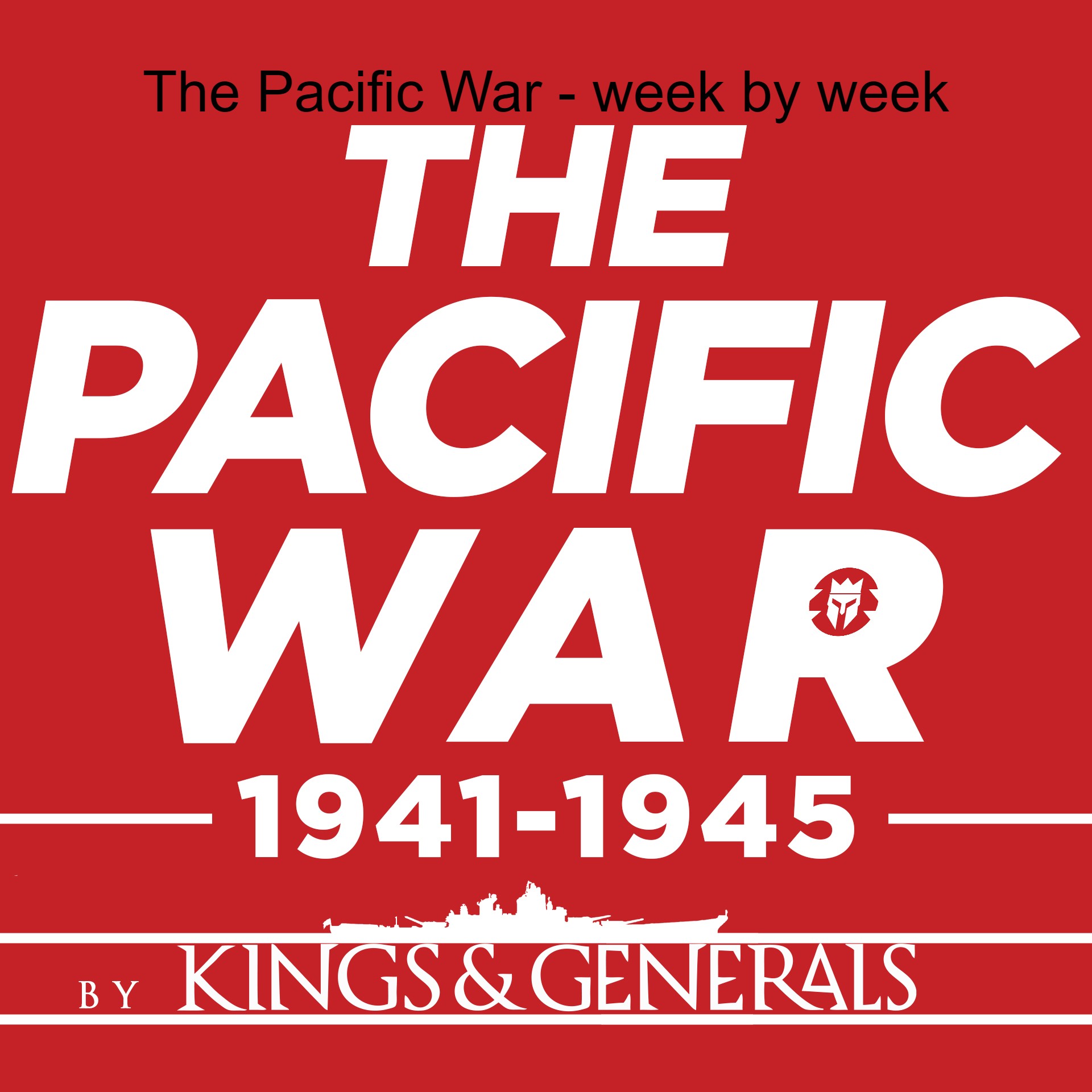 |
The Pacific War - week by weekAuthor: kingsandgenerals
The Pacific War - week by week 80 years after Language: en Contact email: Get it Feed URL: Get it iTunes ID: Get it |
Listen Now...
- 196 - Pacific War Podcast - Battle for South Sakhalin and the Kurile Islands - August 19-26, 1945
Episode 208
Tuesday, 19 August, 2025
Last time we spoke about the Soviet invasion of Manchuria. Following the atomic bombings of Hiroshima and Nagasaki amidst relentless Allied aerial campaigns, chaos engulfed Japan. Prime Minister Suzuki's cabinet debated surrendering to avoid annihilation while fearing for the imperial family's future. Meanwhile, the Soviet Union launched an unexpected invasion of Manchuria, rapidly advancing and catching Japanese forces off guard. As negotiations unfolded, a group of military conspirators, led by Major Hatanaka, attempted a coup to halt the surrender, believing they could rally support. They seized the Imperial Palace but failed to find the Emperor's recorded surrender speech amid the chaos. In a decisive moment, Emperor Hirohito accepted the Potsdam Declaration, stipulating the emperor's continuation, thus sealing Japan's fate. That same day, the world learned of Japan's capitulation, marking the end of the Pacific War. The once powerful nation now lay in ruins, yet the Emperor’s decision bore the weight of a nation saved from further destruction, embodying a fragile hope for the future amidst the horrors of war. This episode is the Battle for South Sakhalin and the Kurile Islands Welcome to the Pacific War Podcast Week by Week, I am your dutiful host Craig Watson. But, before we start I want to also remind you this podcast is only made possible through the efforts of Kings and Generals over at Youtube. Perhaps you want to learn more about world war two? Kings and Generals have an assortment of episodes on world war two and much more so go give them a look over on Youtube. So please subscribe to Kings and Generals over at Youtube and to continue helping us produce this content please check out www.patreon.com/kingsandgenerals. If you are still hungry for some more history related content, over on my channel, the Pacific War Channel you can find a few videos all the way from the Opium Wars of the 1800’s until the end of the Pacific War in 1945. As we previously discussed, the Japanese Empire made the difficult decision to surrender on August 14, amid the turmoil of the Soviet invasion of Manchuria and South Sakhalin. The following day, this decision was announced to the world. However, in Manchuria, General Yamada’s Kwantung Army chose to continue fighting until they received a clear ceasefire order. At this moment, several developments unfolded. General Hongo’s 44th Army was on a forced retreat toward the Hsinking-Mukden line under General Ushiroku's command, leaving their 107th Division trapped behind Soviet lines. Meanwhile, General Iida’s 30th Army was redeploying to Hsinking, which was starting to be evacuated, while General Uemura’s 4th Army had orders to withdraw to Meihokou, taking over positions left by the 30th Army. The advance of enemy armored columns in the west was severely hindering the evacuation of Japanese nationals. On the 10th, the Kwantung Army requested the Manchukuoan Government to facilitate the evacuation of Japanese residents in Hainking and its surroundings. They directed the Continental Railway Command to prepare ten trains for this purpose, with the first train scheduled to depart from Hsinking that same day. However, the Manchukuoan Government found it nearly impossible to carry out the withdrawal swiftly. They managed to transport only the families of officers and civilians linked to the army, and these families had to flee with just a few hours’ notice, taking almost nothing but the clothes on their backs. By the 12th, Hsinking was in a state of chaos. The advance of enemy armored units, coupled with the retreat of the main force of the 44th Army, led to the evacuation of the capital by the Kwantung Army General Headquarters. This turmoil coincided with the arrival of the first refugee trains, carrying Japanese evacuees from the western border areas, causing widespread panic among local residents. Many hurried to the already overcrowded train station, desperate to escape the unfolding crisis. In the face of enemy pressure, the 80th Independent Mixed Brigade and the 119th Division continued to resist assaults at Hailar and Pokotu, respectively. The 123rd Division and the 135th Independent Mixed Brigade were heavily engaged in the fortified regions of Sunwu and Aihun, and the 136th Independent Mixed Brigade was directed to reinforce Tsitsihar, while the 134th Division retreated to Fangcheng. General Shimizu’s 5th Army prepared for a last stand at Mutanchiang, while the isolated 124th Division made plans to withdraw. The 132nd Independent Mixed Brigade had already retreated to Tachienchang, and the 128th Division was getting ready to confront the enemy advance at Lotzokou, with General Murakami’s 3rd Army holding strong in the Tumen fortified region. Meanwhile, the Nanam Divisional District Unit successfully repelled an amphibious invasion in Chongjin, and the 88th Division’s 125th Regiment staunchly defended Furuton on South Sakhalin. In a desperate bid to avoid further disaster, Yamada finally instructed Ushiroku to adhere to their original plan and prepare for a withdrawal to the Hunjen area, even if it meant leaving Japanese citizens and their cities vulnerable to the approaching Soviets. Ushiroku hesitantly agreed to the order but never got the chance to act on it. On August 15, Marshal Vasilevsky’s offensive advanced much like the previous days, facing an enemy that continued to resist fiercely. To counter this, orders came to intensify the assault to gain control of key operational and strategic points as quickly as possible. In Marshal Malinovsky’s Transbaikal Front, General Pliyev’s cavalry-mechanized units encountered heavy opposition from the Inner Mongolian 3rd, 5th, and 7th Cavalry Divisions at Kanbao. Meanwhile, General Danilov’s 17th Army pressed toward Chihfeng but was hindered by water shortages, intense heat, and challenging sandy terrain. General Managarov’s 53rd Army began its advance toward Kailu, while General Kravchenko’s 6th Guards Tank Army continued its march along two fronts. The 7th Guards Mechanized Corps moved east toward Changchun, while both the 9th Guards Mechanized Corps and the 5th Guards Tank Corps advanced southeast toward Mukden. Notably, General Lyudnikov’s 39th Army finally captured Tepossi and Wangyemiao. Heavy Japanese resistance persisted in the sector of the 36th Army, notably in the Hailar Fortified Region and along the road and rail line through the Grand Khingan Mountains leading to Pokotu. The Japanese 119th Infantry Division put up a determined defense of Pokotu, successfully delaying the Soviet forces of the 2nd Rifle Corps from August 15 to 17, despite heavy rainfall. Meanwhile, in the rear of the 36th Army, the fighting in Hailar remained intense. The 86th Rifle Corps employed heavy artillery to systematically dismantle enemy strongholds in the hills to the northwest and southwest of the city. Position after position fell to relentless artillery bombardments, combined with sapper and infantry assaults. Ultimately, the Soviets extinguished the last vestiges of Japanese resistance in Hailar on August 18 when the remaining garrison of 3,827 men surrendered. Concurrently, in Marshal Meretskov’s 1st Far Eastern Front, forward detachments of General Zakhvatayev’s 35th Army secured Poli. General Beloborodov’s 1st Red Banner Army broke through the frontline of the 135th Division and initiated an assault on the last Japanese positions just outside Yehho. Meanwhile, General Krylov’s 5th Army, having successfully breached the Ssutaoling heights the previous evening, launched attacks against the 126th Division’s positions at Aiho but was ultimately repelled by the defenders. In light of these developments, Generals Kita and Shimizu decided to order a withdrawal toward Hengtaohotzu, which they executed successfully after sunset, leaving behind some units to cover the retreat. Further south, General Chistyakov’s 25th Army split into two columns at Heitosai. The 17th Rifle Corps and the 72nd Mechanized Brigade advanced west toward the Taipingling Pass, while the 39th Rifle Corps, along with the 72nd and 257th Tank Brigades, headed southwest toward Wangching. The 17th Rifle Corps effectively breached the main defenses of the Japanese 128th Division, forcing it to retreat to second-line positions southwest of Taipingling. On the morning of August 15, enemy air activity against Army Headquarters intensified significantly. Meanwhile, the Army Commander and several staff officers set out via Pataohotzu to inspect the defenses in the Hoeryong area, where the 101st Regiment was retreating from the Chonghak sector. At noon, while at the headquarters of the 127th Division in Pataohotzu, General Murakami and his accompanying staff listened to the Emperor's broadcast announcing the termination of the war. Opinions among the officers were divided regarding the veracity of this broadcast. After a brief discussion, they decided to continue military operations as per existing instructions until they received a formal cessation order. Later that night, a formal order arrived from First Area Army Headquarters, directing that all active resistance be halted, though self-defense measures were still to be implemented if necessary. Around the same time, a report came in from the 1st Mobile Brigade indicating that their positions in the Wangching area, about 25 miles northeast of Army Headquarters at Yenchi, were under attack by a sizable Soviet tank force. In response, a counterattack force was hastily assembled, consisting of two infantry battalions from the 127th Division. They were directed to advance to Wangching along the Yenchi-Chiulungping road to confront the enemy tanks. These battalions likely included the 3rd Battalion of the 280th Regiment and the 3rd Battalion of the 281st Regiment. Additionally, the 88th Rifle Corps took control of Hunchun and crossed the Inanho River, where they encountered well-entrenched Japanese forces from the 112th Division. To further pressure the enemy, the 258th Rifle Division crossed the Tumen River at Hunyong to attack the Japanese right flank. In General Purkayev’s 2nd Far Eastern Front, General Mamonov’s 15th Army continued its two-pronged advance toward Chiamussu, while General Pashkov’s 5th Rifle Corps pushed forward to Poli. Meanwhile, General Teryokhin’s 2nd Red Banner Army assigned some elements to maintain the siege of Sunwu and Aihun while forward detachments bypassed these fortified regions, moving south toward Nencheng and Peian. In South Sakhalin, General Cheremisov’s 16th Army faced fierce resistance from Japanese forces at Furuton. Admiral Andreyev’s Northern Pacific Flotilla prepared for an amphibious landing at Toro, while the Pacific Fleet, under Admiral Yumashev, successfully landed Major-General Vasily Trushin’s 13th Naval Infantry Brigade at Chongjin in the early hours of August 15. This effort aimed to relieve the besieged Soviet naval units and gradually push back against the defending Japanese forces. On August 16, the entire Soviet force, commanded by Lieutenant-General Sergey Kabanov, secured Chongjin city and its port after overcoming strong resistance, just as the 393rd Rifle Division was arriving in the area. Simultaneously, Andreyev’s fleet departed from Sovetskaya Gavan and approached Toro in the early hours of the day. At 05:17, 141 marines from the initial reconnaissance detachment successfully landed ashore quietly, and by 06:00, they had taken the port with virtually no opposition. The reconnaissance group then advanced about three kilometers east, where they encountered heavy resistance; meanwhile, the rest of the marine battalion landed successfully by 10:00. After securing Shakhtyorsk at midday, the Soviet marines began their push south toward Esutoru, their main objective, while a supporting infantry battalion landed behind them. To the north, the 56th Rifle Corps managed to break through and capture Furuton, though it failed to seize the strategically significant Happo Mountain. In Manchuria, the 88th Rifle Corps continued its attacks on the 112th and 79th Divisions but was unsuccessful. The 39th Rifle Corps column advanced toward Tumen and Yenchi, while the 17th Rifle Corps column effectively expelled Japanese forces from the Taipingling area to secure the pass. By evening, units from the 1st Red Banner Army cleared Mutanchiang, and the 5th Army units moved south of the city to continue their southwest advance toward Ningan. The 15th Army executed a coordinated amphibious assault, successfully capturing Chiamussu. The 39th Army advanced along the railroad from Wangyemiao to Changchun, with its main force ultimately securing Taonan by the end of the day, while other units reduced the Halung-Arshaan fortified region. Finally, forward detachments of the 5th Guards Tank Corps and the 9th Guards Mechanized Corps secured Tungliao and Kaitung, respectively. On August 17, Prince Takeda Tsuneyoshi, on behalf of the Emperor, arrived at Hsinking to deliver the official ceasefire order. However, this did not cancel ongoing operational missions, as the order stipulated that the cessation of hostilities did not apply to unavoidable acts of self-defense during enemy attacks made before the completion of armistice negotiations. Tokyo’s orders demonstrated that Yamada was authorized to conduct on-the-spot negotiations for an armistice with the Soviets. Consequently, the Manchurian Campaign continued amidst the negotiations. Pliyev’s Soviet-Mongolian units successfully defeated the Inner Mongolians at Kanbao; the 17th Army overcame light opposition from the 108th Division to occupy Chihfeng; the 39th Army concentrated its forces at Taonan while the 94th Rifle Corps mopped up rear areas; and the 36th Army defeated the 119th Division to capture Pokotu. Simultaneously, the 2nd Red Banner Army directed heavy artillery and air strikes to reduce the Aihun and Sunwu Fortified Regions, while the 15th Army initiated a push south along the Sungari River toward Sansing. The 363rd Rifle Division passed through Chihsi, with the 66th Rifle Division focusing on Poli. Units from the 1st Red Banner Army advanced northwest toward Harbin, and the 72nd Rifle Corps marched southward along the east bank of the Mutan River, attempting unsuccessfully to cross the river north of Ningan. The 17th Rifle Corps pursued the 128th Division, and forward elements of the 10th Mechanized Corps moved sixty kilometers from the Taipingling Pass to secure the critical rail and road junction at Tahsingkou. Additionally, the reinforced 72nd Tank Brigade intercepted the counterattacking force of the 127th Division at Nianyantsun. The 39th Rifle Corps broke through the northern defenses of the 79th Division to seize the outskirts of Tumen, while the 88th Rifle Corps successfully pushed aside enemy defenders at Mayusan to occupy Onsang. At South Sakhalin, as the marine force surrounded Esutoru, the 22nd Independent Machinegun Company was deployed to support the marine assault, which quickly penetrated the urban area and secured the city by midday. Meanwhile, fighting continued around Mount Happo, where the 214th Tank Brigade was dispatched south toward the ultimate objective of Toyohara. However, given the distance involved, it was decided to conduct a second amphibious assault on the port of Maoka. On August 18, Yamada finally issued the ceasefire orders to the 1st, 3rd, and 17th Area Armies, as well as to the 4th Army and the 2nd Air Army. His chief of staff, Lieutenant-General Hata Hikosaburo, met with Marshal Vasilevsky in Harbin to discuss procedures for disarmament, the protection of Japanese nationals in Manchuria, and related matters. Meanwhile, the Kwantung Army Headquarters made extensive efforts to relay as much information as possible about the termination of hostilities and disarmament to its subordinate commands using all available communication methods. However, these efforts were hindered by the wide dispersal of forces, many of which initially refused to surrender. General Higuchi’s 5th Area Army received the ceasefire orders on August 17. Although he quickly notified his units—particularly those in Sakhalin and the Kuriles, war continued in these islands for a short period as he sought to prevent a potential invasion of Hokkaido. In Sakhalin, Major Yoshio Suzuki, the Chief of Staff of the 88th Division, received Higuchi's combat order on the afternoon of August 16, preparations for ceasefire were already underway, such as the disbandment of mobilized units, the discharge of some troops, and the disposal of the regimental flag. The division had no tanks or aircraft, and certainly no anti-tank or anti-aircraft weapons that could withstand Soviet forces. In light of this, Suzuki quickly ordered the re-arming of units and the occupation of positions, in accordance with the desire of Mineki and Higuchi to prevent the fall of South Sakhalin and a possible invasion of Hokkaido. Civilians, at this point, were already voicing complaints, wondering if the military was still going to continue fighting. After the surrender of the 125th Infantry Regiment, the Japanese command in the Northern District was effectively assumed by the staff of the 88th Division stationed at Kamishikika. During the fighting on the central military road, by the morning of August 17, evacuation of the civilian population from Kamishikika had been completed, and the town was burned to the ground by Japanese forces' scorched earth tactics, along with an air raid by 20 Soviet aircraft. Kamishikika was abandoned on August 20, marking the start of a full retreat. The construction of a defensive line involving the destruction of the Uro Bridge and the Chidori River Bridge was considered but ultimately abandoned due to the presence of evacuees. Meanwhile, in the Kuriles, a new operation was unfolding. According to Vasilevsky’s orders, once operations against Manchuria and South Sakhalin were sufficiently advanced, a small force from the Kamchatka Defense Region, supported by naval units from the Petropavlovsk Naval Base, was to conduct amphibious assaults on the Kuril Islands in preparation for a future landing at the port of Rumoi on Hokkaido’s west coast On August 15, President Truman and Soviet Premier Stalin agreed that Japanese forces north of the 38th Parallel would surrender to the Soviets, while those to the south would surrender to the Americans. Stalin’s agreement surprised the US, as there was little chance of American forces landing on the Korean peninsula at that time. In what many scholars interpret as an attempt to achieve reciprocal generosity from Truman, Stalin proposed amending the order to include the northern half of Hokkaido and all of the Kuril Islands in the region of surrender to Soviet forces. This northern portion, he stated, should be demarcated by a line drawn ‘from the town of Kushiro on the eastern coast . . . to the town of Rumoe (Rumoi) on the western coast . . .’, with both towns included in the occupation area However, Truman only acquiesced concerning the Kuriles, honoring the pact reached at Yalta, while specifying that all the islands of mainland Japan were to surrender to General MacArthur. Nonetheless, concerned by the exclusion of the Kuriles from the original agreement, Stalin instructed Vasilevsky to organize landings to occupy the islands. This mission was assigned to Purkayev’s 2nd Far Eastern Front and Yumashev’s Pacific Fleet, which, in turn, designated Major-General Aleksei Gnechko’s Kamchatka Defense Region and Captain Dmitri Ponomarev’s Petropavlovsk Naval Base to execute the first landings on Shumshu and Paramushir, followed by a subsequent amphibious assault on Onekotan. These inexperienced commanders had limited time to plan for their operations, assemble the necessary commercial vessels for transportation, and hurriedly gather the army units dispersed across Kamchatka. Ultimately, the primary unit chosen for the landings was Major-General Porfiry Dyakov’s 101st Rifle Division, supplemented by a battalion of marines. Meanwhile, Ponomarev managed to gather an invasion flotilla of 64 vessels. Although the Soviets had air superiority, it was unreliable due to the peculiar climatic conditions. “There were very peculiar climatic conditions in the Far East and Sakhalin; almost every airfield had its own special microclimate. In the coastal zone, frequent outbursts of moist sea air, forming a curtain of thick fog, caused a lot of trouble.”. The limited firepower of Ponomarev’s flotilla forced the Soviets to land on the northeast corner of Shumshu, which could be targeted by the coastal guns at Cape Lopatka. Additionally, Gnechko planned a diversionary landing on the southeast side of the island. Opposing the Soviets, Higuchi had Lieutenant-General Tsutsumi Fusaki’s 91st Division garrisoning the northern islands of Shumshu and Paramushir, the 41st Independent Mixed Regiment on Matsuwa Island, the 129th Independent Mixed Brigade on Uruppu Island, and Lieutenant-General Ogawa Gonosuke’s 89th Division stationed on the southern islands of Etorofu, Shikotan, and Kunashiri. Shumshu is the northernmost island in the Kuril chain, separated from Cape Lopatka, the southernmost tip of the Kamchatka Peninsula, by the 11-kilometer-wide First Kuril Strait. Covering an area of approximately 388 square kilometers and roughly oval in shape , Shumshu’s proximity to Soviet territory, similar to its larger neighbor to the south, Paramushir, ensured that it was strongly defended. The garrison on Shumshu comprised about 8,500 troops, whereas the larger island boasted a garrison of approximately 14,500. The strait between the two islands narrows to about 2.5 kilometers at its smallest point, thus allowing these garrisons to provide mutual support. As Slavinsky notes: “Shumshu and Paramushir, with their naval bases located opposite each other on both sides of the Second Kuril Strait, were, in essence, a single key position.” The capture of Shumshu was crucial to the success of subsequent island operations. While there were several airfields on these islands, they housed very few aircraft, which had been withdrawn earlier to the Japanese main islands in preparation for the anticipated “final battle” with the Americans. However, Shumshu was defended by a tank force from the 11th Tank Regiment, commanded by Colonel Sueo Ikeda. This force consisted of thirty-nine medium tanks, including nineteen Type-97 Chi-Ha tanks and twenty Type-97 ShinHoTo Chi-Ha (improved Type-97) tanks, alongside twenty-five Type-95 Ha-Go light tanks. Both Shumshu and Paramushir were equipped with permanent defensive works along the coast and inland. On Shumshu, these defenses included 34 bunkers and 24 pillboxes within several powerful strongpoints, featuring around 100 guns of varying calibers, some reaching up to 100mm. Approximately 300 prepared firing points were established for both heavy and light machine guns. Most of Shumshu’s coast is bordered by cliffs, leading to a concentration of the strongest defenses in areas deemed vulnerable to amphibious assault. Notably, a battery was installed in the wreck of the Soviet tanker Mariupol, which had become stranded on the beach between Cape Kokutan and Cape Kotomari in 1943. Although the island is relatively flat, it possesses several hills with sides that are nearly bare of trees, and these heights also housed additional strongpoints. Shumshu features 120 kilometers of roads, which facilitated terrestrial communication between various points. Additionally, the garrison constructed numerous dummy installations to mislead reconnaissance efforts. Nevertheless, Ponomarev’s flotilla departed from Petropavlovsk-Kamchatsky at approximately 05:00 on August 17, moving slowly and stealthily toward their objective in foggy conditions. This weather ultimately forced Gnechko to cancel the planned diversionary landing. In any event, the first landing craft approached the beach at 04:22 hours on 18 August still hidden in the murk, but were forced to halt some 100–150m from shore in water up to 2m deep; they had been overloaded which prevented them getting closer in. The troops of the advanced detachment (two companies of marines, a maritime border guard company, and a submachine gun company) had then to wade, heavily burdened, to dry land. This went on undisturbed until personnel on one of the landing craft opened fire; this, spreading to the other ships, alerted the defenders, who replied with ‘promiscuous’ machine-gun fire. Nevertheless, by 05:00 hours, and having suffered only ‘insignificant’ losses, the advanced detachment was ashore and its main force, under Major Pyotr Shutov, was moving off the beach into the interior of the island. Two groups of marines moved left and right to deal with enemy positions on the capes flanking the landing ground. They managed to destroy several firing points, but were too few to overcome the stronger resistance nests protecting the gun positions. A series of hills inland formed the initial objective of the advance. Behind them, Dyatlov’s first wave faced heavy bombardment from Japanese artillery, suffering significant casualties as the troops struggled to scramble ashore by 09:00. The second wave experienced a similar fate but managed to disembark by 13:00, joining the first wave in advancing on the high ground to the southwest. This second wave successfully repelled a series of Japanese tank counterattacks, resulting in the loss of Colonel Sueo. Despite being pushed back somewhat, the Soviets held their position while their aircraft targeted the naval bases on the island's southern side, aiming to hinder reinforcements from Paramushir. By nightfall, Gnechko’s forces had secured a beachhead approximately 4 kilometers wide and 5 kilometers deep, while assault groups successfully destroyed Japanese artillery positions on Cape Kokutan and Cape Kotomari. Meanwhile, Kabanov’s new Southern Defense Region command was ordered to quickly land naval units at Odaejin and Gensan to prevent the Japanese from evacuating their forces from Korea to the Home Islands. Consequently, a small naval force from the 13th Naval Infantry Brigade departed from Chongjin, successfully landing unopposed at Odaejin at 08:00 on August 18. Elsewhere in eastern Manchuria, the 25th Army consolidated its hold on northeastern Korea, dispatching the 10th Mechanized Corps west toward Tunhua and Kirin and northwest toward Tungchingcheng amidst the surrender of Murakami’s 3rd Army. The 72nd Rifle Corps successfully crossed the Mutan River north of Ningan, while units from the 1st Red Banner Army and the 5th Army were deployed to receive and process surrendering Japanese units of Shimizu’s 5th Army. To the north, the 2nd Red Banner Army maintained pressure on the Aihun and Sunwu Fortified Regions, leading to the surrender of the 123rd Division, although the 135th Independent Mixed Brigade continued to resist at Aihun. Be that as it may, the Japanese artillery positioned at Cape Kokutan and Cape Kotomari wreaked havoc on the second echelon, which was comprised of the 373rd Rifle Regiment. During this engagement, a patrol boat and four landing craft were lost, while eight others sustained serious damage. Once again, Soviet troops were forced to improvise ways to reach dry land; however, this time, the echelon's commander, Colonel P.A. Artyushen, along with his headquarters, managed to land via a torpedo boat. It took until 13:00 hours to fully disembark the second echelon, by which point its forward units had linked up with those forces advancing on the high ground to the southwest. By then, Artyushen had assumed command of all the forces ashore. While the number of troops was considerable, they still lacked heavy weapons, with only four 45mm anti-tank guns having been landed. Unsurprisingly, the Japanese counterattacked as soon as possible, with the advanced forward units under Shutov bearing the brunt of the assault. In a reversal of the combat situations previously encountered throughout the war with Japan, Soviet infantry now found themselves facing several tank attacks from the Japanese. One of these assaults was personally led by Colonel Sueo Ikeda, the commander of the 11th Tank Regiment, who was reported to be waving a samurai sword and Japanese flag from the turret, according to some accounts. Fortunately for the Soviets, these Japanese tanks were relatively weak compared to the T-34. While they posed a threat to unsupported infantry, they proved vulnerable to Degtyarev PTRD-41 anti-tank rifles and RPG-43 anti-tank grenades. The tank-led attacks were ultimately repelled, with Colonel Sueo perishing in the fighting. Despite being pushed back somewhat, the Soviets managed to withstand the onslaught. For his heroism during this challenging combat situation, in which he was wounded three times, Shutov was awarded the title of Hero of the Soviet Union, along with the Order of Lenin and the Golden Star medal. Despite being somewhat pushed back, the Soviets held their ground while their aircraft targeted the naval bases on the southern side of the island to hinder reinforcements from Paramushir. The weather cleared sufficiently in the late morning, allowing Soviet air strikes to commence that afternoon. These strikes involved groups of eight to sixteen aircraft and were primarily directed at the Kataoka and Kashiwabar naval bases, successfully preventing the transfer of Japanese reinforcements from Paramushir. However, the sky remained cloudy enough to hinder any close battlefield support. As Zakharov et al. described it, the situation on the ground “remained tense.” The thinning fog later allowed seven Japanese aircraft to appear at 10:30 hours, attempting to strike at the shipping gathered off the landing beach. Their first strike targeted the Kirov, but it was unsuccessful, and the attackers were driven off by anti-aircraft fire. A second attempt at 12:00 hours focused on the minesweeper T-525, which also failed, resulting in two of the attacking aircraft being shot down by gunfire. By nightfall on 18 August, it was evident that the Soviet landing had succeeded to the point where the forces would not be driven back into the sea. The invasion force had established a beachhead approximately 4 kilometers wide and 5 kilometers deep, and they were capable of defending this position against any immediate Japanese counterattacks, despite most of their artillery still being stuck offshore. Gnechko, stationed at Petropavlovsk-Kamchatsky, ordered that enough artillery be transported ashore overnight to resume the offensive, with the goal of occupying the island by the end of 19 August. He also dispatched several self-propelled barges and kungas (shallow-draft boats used for fishing or transport) to assist with the unloading, although these vessels could not arrive until the following morning. To eliminate further artillery attacks on shipping, assault groups were formed to attack and destroy the Japanese strongpoints on Cape Kokutan and Cape Kotomari during the hours of darkness. Shortly after midnight on 17 August, a second order regarding the cessation of hostilities was received from the First Area Army, directing that all fighting be stopped. At daybreak, General Murakami dispatched his intelligence chief, Lt. Col. Fujimoto, to Chiulungping to inform the Soviet tank battalion commander of the end of hostilities. Simultaneously, he ordered all divisions under his command to cease all combat operations. At approximately 16:00 hours, the Soviet tank battalion commander arrived at the Army Officers Club in Yenchi, where he conferred with Major General Hanjiro Iketani, the Army Chief of Staff. The following day, General Iketani traveled to Wangching to conduct armistice negotiations. The 72nd Rifle Corps finally crossed the Mutan River north of Ningan, while units from the 1st Red Banner Army and the 5th Army were deployed to receive and process the surrendering Japanese units of Shimizu’s 5th Army. Since the Army began its withdrawal, communications with Area Army Headquarters in Tunhua had been completely disrupted. On the morning of the 17th, a member of the Manchurian Telegraph and Telephone Company's Harbin office sent a message via railway telephone concerning disarmament, stating that he had been asked by the First Area Army Headquarters to relay the information. The Army Commander and his staff, however, suspected it might be another ruse from the enemy's fifth column. They agreed to exercise caution in addressing the matter and decided to send Staff Officer Maeda to Area Army Headquarters in Tunhua by railway gasoline engine car to verify the truth. Colonel Maeda proceeded to the railway station, and while preparing to depart, he received a railway telephone call from Staff Officer Tsumori at Area Army Headquarters regarding the cease-fire order. Subsequently, around 14:00 hours, the Army convened a meeting with representatives from each unit to announce the cease-fire orders. That evening, Soviet forces began entering Hengtaohotzu and immediately started disarming Japanese forces. Looking west, the bulk of the 36th Army advanced southward and seized the railroad station at Chalantun amid the surrender of the 119th Division. The 86th Rifle Corps, after several days of intense artillery bombardment, finally extinguished the last remnants of Japanese resistance at Hailar, forcing the 80th Independent Mixed Brigade to surrender. Meanwhile, the 39th Army forces prepared for transport to Changchun and then on to the Liaotung Peninsula. The 17th Army moved toward the coast, capturing Pingchuan and Linguan before reaching the coastline at Shanhaiguan, directly across from the Liaotung Peninsula. Additionally, Pliyev’s Soviet-Mongolian forces approached the outskirts of Kalgan, where they encountered a small contingent of the China Expeditionary Army. Indeed, with the surrender of the Kwantung Army, the war was coming to an end. However, several independent units, including the one mentioned, would continue to resist into the last days of August, thereby prolonging the Pacific War by another week. I would like to take this time to remind you all that this podcast is only made possible through the efforts of Kings and Generals over at Youtube. Please go subscribe to Kings and Generals over at Youtube and to continue helping us produce this content please check out www.patreon.com/kingsandgenerals. If you are still hungry after that, give my personal channel a look over at The Pacific War Channel at Youtube, it would mean a lot to me. In August 1945, amidst Japan's turmoil, the Soviet Union surprisingly invaded Manchuria. As chaos ensued, Japanese forces in South Sakhalin faced robust Soviet resistance. Ultimately, Japan's surrender shattered its imperial power, marking a historic end to the Pacific War, leaving a nation in ruins yet igniting a fragile hope for the future beyond the horrors of conflict.










